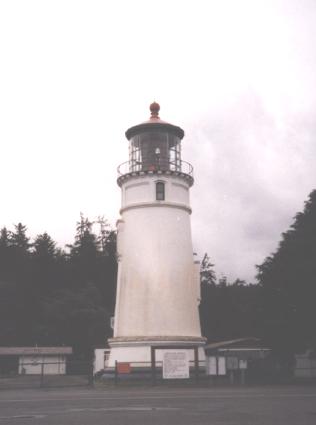Reedsport, Oregon, USA (May 1998)

The Umpqua River Lighthouse seemed to be located surprisingly inland, further inland than any other lighthouse along the Oregon coast, about a half-mile from the shore it protects (map). An earlier lighthouse sat closer to the oceanfront on the other side of the river in 1857 but succumbed to fierce weather just a few years later. The current incarnation dates to 1894, set atop a headland high above the south mouth of the river. It warns ships of great dangers and strong river currents plowing headlong into the Pacific Ocean along a rugged coastline.
This tapered tower features bricks covered by plaster, rising 65 feet atop a 100 foot bluff, extending its focal plane significantly. Walls measure five feet thick at the base and nearly two feet or so at the top. This lighthouse shouldn’t suffer the same fate as its predecessor anytime soon. A first order Fresnel lens — “a big one” — shines with the intense candlepower necessary to push through ferocious Pacific storms to guide ships several miles from shore. The Upqua River Lighthouse became automated in the 1960’s and continues to serve as a navigational aid even today.
This lighthouse serves as the crowning monument of a State Park with the same name. Elsewhere in the park, visitors can also find a campground, walking trails, and picnic spots. A small lake rests nearby, trapped between the dunes. It cradles a sandy swimming beach and a marina for fishing or canoeing.
Along with all that, Umpqua serves as a northern gateway into the spectacular Oregon Dunes National Recreation Area and its towering 500 foot sand dunes.
Readers who have an interest in lighthouses might also want to check my Lighthouse Index page.

Leave a Reply